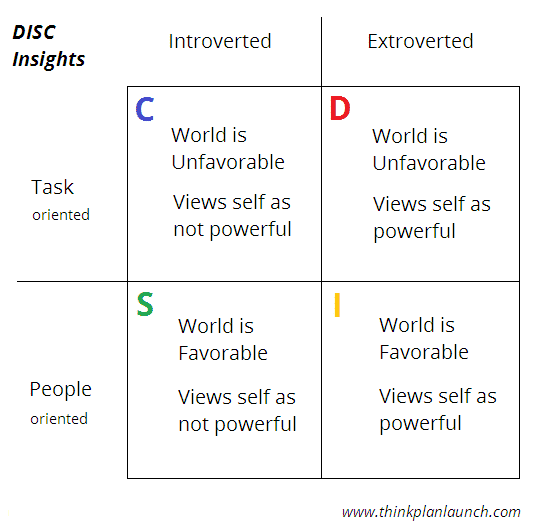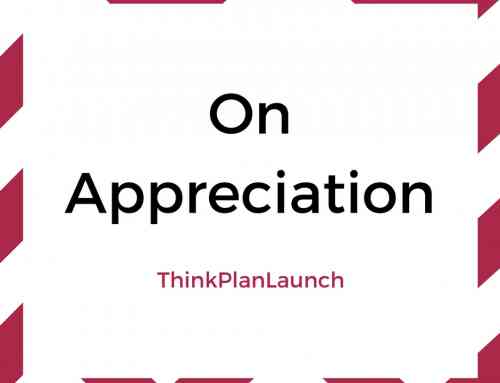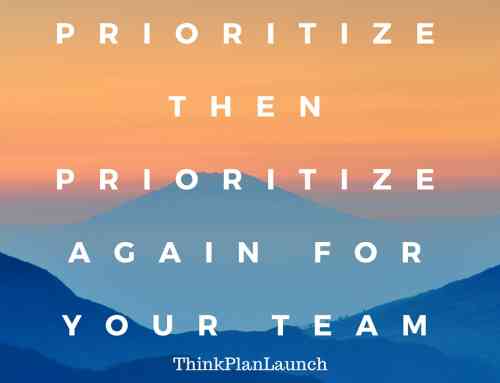In this article, we will explore the nature of the “High-C” as ranked by a DISC test.
Table of Contents
Reminder: DISC measures behavior and communication style.
When we talk about exploring the nature of the High-C, what we are referring to is their visible behavior and communication style.
Remember, DISC is not actually a measure of personality even though many people think of it that way. Behavior and communication style are but two components of personality, which is comprised of many more elements.
“C” stands for Compliant.
The letter “C” in High-C stands for Compliant (some practitioners of DISC would also say it stands for Conscientious). Simply put, the High-C is someone who is diplomatic, careful, and exacting. They have naturally high attention to detail, but their careful nature can spiral into anxiety and worry if they aren’t careful! Keep reading to learn more about the High-C.
Summary of the High-C.
- Balanced, careful, and exacting.
- Open-minded, systematic, and neat.
- Task-oriented and introverted.
- Views world as unfavorable.
- Views self as not powerful.
- Communicates in a diplomatic manner.
- Calculates with accuracy; good at managing information.
- May get caught up in worry or anxiety due to high standards for self and others.
- Examples: Isaac Newton, Monica Geller (from Friends!), Jack Nicklaus, anyone who is highly technical.
Adjectives that Describe the High-C.
The High-C is conscientious in their communication and wants to “get it right” with their projects and communications. Here is a list of adjectives associated with the High-C:
- Balanced
- Open-minded
- Tactful
- Diplomatic
- Systematic
- Exacting
- Cautious
- Dependent
- Careful
- Anxious
At the extreme (or when under stress), the High-C can become pessimistic, fussy, and a perfectionist. This stems from the High-C’s strong desire for accuracy and organization.
Being a relatively High-C myself (and knowing plenty more), I can speak to the truth of this. There is often much vacillation when making a decision for fear of not making the right choice.
Orientation and Attitude of the High-C.
The High-C is task-oriented (as opposed to people-oriented) and introverted. They view the world around them as unfavorable. Furthermore, they do not believe in their personal ability to effect change upon the world around them. In other words, they view themselves as not holding power over their circumstances. This does not mean the High-C is not confident or incapable of setting goals – in fact, many times it’s quite the opposite. But they tend to believe the forces at work around them are more powerful than they are; that they are ultimately governed and subject to those forces.
This graph depicts the situation well for all DISC types:

This graph illustrates how each DISC type views the world around them, and how they view themselves; as well as their fundamental orientations.
Since the High-C views the world as unfavorable, someone with a high Compliance score may be prone to feeling they are often in a “hostile” environment.
This, however, is not a black-and-white matter. It does not necessarily mean the High-C is not optimistic (though they do tend to be more skeptical and pessimistic by nature), nor does it mean the High-C doesn’t see, feel, or acknowledge the good things in life around them. It also is not a measure of emotional intelligence.
Perhaps the best way to explain how the High-C sees the world is with the world “careful.” The High-C constantly strives to “get things right” out of fear they may take a misstep, and while this leads to very high work quality and dependability, it can also lead them to be very tough on themselves and others due to their high standards.
What do you think of when you hear the word “careful?” Do you generally view being careful as a positive, sensible trait? Or do you see it as a setback, something that spawns unnecessary worry, delays, and anxiety? The truth is that it’s a little bit of both. Taken to the extreme, being overly careful and cautious can certainly be a setback. However, can you imagine what life would be like without people who are careful, such as engineers? Bridges would collapse, airplanes wouldn’t fly, cars wouldn’t run, computers wouldn’t work, and high rises wouldn’t stand for long.
How the High-C Views Him/Herself.
The High-C typically sees him/herself as thorough, analytical, and moderate. The higher the High-C’s emotionally intelligence, the more likely others will perceive them this way, too.
But How do Others View the High-C?
If the High-C’s emotional intelligence is on the lower end, or if they are under moderate stress, others may come to view the High-C as worrisome, defensive, and hard to please!
When the High-C is under extreme stress, their behavior might be perceived as strict, perfectionistic, and overly picky. But why?
When a High-C feels like things aren’t going according to plan – or worse, aren’t being done properly, they may take drastic measures to assure people get back on track. This will typically manifest with them enforcing high standards on themselves and others, coupled with a defensive and strict attitude.
As with all of the other styles, this comes from a place of good intentions – they want things to be done right for the greater good of everyone. Unfortunately, the unintended fallout from such behavior can undermine the High-C’s true objectives. It can make others feels like they are never good enough, give the perception of impossible standards, and ultimately reduce buy-in from their peers. Therefore the High-C must be careful to keep his/her emotions in check, and moderate language used when communicating with others.
The High-C’s Strengths.
The High-C is prone to become a stickler for getting things absolutely right, but frankly – we really need people like this! They are dependable, they follow through, and they can be trusted to do their work properly.
The High-C will work long hours to ensure standards are met, and will ask the right questions to move things forward. They will stay on task and pay attention to small, important details others tend to miss. They are conscientious in their dealings with others (for the most part) and seek positive outcomes through their analytical, if not critical approach to their work.
These qualities make many High-C’s excellent technical workers. Many High-C’s are successful engineers, scientists, astronauts, computer programmers, mathematicians, accountants, and attorneys. There are many High-Cs working in STEM fields because of their ability to gather information, test ideas, and reach new heights of technical development.
Since the High-C is a “get things right” person, they will tend to be objective and unemotional in their assessment of the situations they are presented with – unless under extreme stress. Furthermore, they naturally will plan and organize things in such a way to ensure follow through is all but guaranteed.
The High-C’s Weaknesses.
Just as the High-C has a long list of strengths, so too they have some weaknesses.
We have already discussed how the High-C can become strict and defensive under stress. But what else is there?
Because the High-C tends to be a perfectionist, they may vacillate for a long time and fail to make timely decisions (a.k.a. “information paralysis”). They can get overly bogged down in details to the point of missing deadlines, or push them back since things cannot be done “perfectly” prior to the scheduled time.
The High-C may also alienate others unintentionally, only selecting people much like themselves. This is because they prefer people who have a perceived ability to get things done like they do – accurately and with intention. In turn, this can cause them to overlook significant strengths brought to the table from people with other dominant behavioral styles.
Finally, the High-C will often internalize their emotions and feelings rather than communicating them to others, and be too hard on themselves. This can reduce confidence and in turn influence motivation, for themselves and the people around them. The lack of communication about feelings can create a cold or distant feeling for team members with people-oriented styles, as well.
Tips for Communicating with a High-C.
“Get it right!” is a common jingle to remember, and it will take you far with the High-C – especially if he/she is your boss.
Remember, the High-C tends to prefer people like themselves – conscientious types will appear more trustworthy and valuable to them than “goofy” High-Is or “emotionally unstable” High-Ds. The High-S will typically get a free pass from the High-C because they have a similar propensity for planning and organizing – and they have a similarly quiet demeanor – but because the High-S is more people oriented than the High-C, the High-C may perceive the High-S as a less intelligent, or less capable version of themselves.
Things that will upset a High-C include:
- Being informal or overly friendly
- Being loud or “obnoxious”
- Imposing deadlines that reduce work quality
- Making a mess or being disorganized
- Taking the conversation away from the task at hand
Things that will make a High-C happy include:
- Being well-prepared and well-spoken
- Presenting facts, figures, and data
- Demonstrating accuracy of analysis
- Staying on task and sticking to business
- Being realistic with projections and estimates
Remember, the High-C is looking for accuracy and follow-through. They succeed by getting things done properly, and they want the people around them to share their similarly high standards. If they are your boss, you could find yourself out of a job if you consistently fall short of the High-C’s expectations – and if they are your employee, you may find them moving onto greener pastures if they feel your company culture or management style is careless or inattentive to important details.
Speak in terms of facts and figures when communicating with High-Cs, and stay on task. If you focus on this, you’ll do alright!
Tips for Communicating with Others as a High-C.
If you are a known High-C (or you’re pretty sure you are!), here’s what you need to know:
As discussed earlier, others can easily come to view you as strict, defensive, and overly pessimistic if you aren’t careful. What you may view as an effective and conscientious approach to your work could be viewed by others as cold and pathological.
Some people, especially family members, may come to view you as lifeless or emotionless because of your task orientation and limited communication about your emotions. This can undermine your goals in ways you may not have previously considered, by diminishing communication and hurting feelings of the people around you.
As a High-C, you know that you have good intentions – so it may be frustrating to think that others perceive you this way. After all, you work hard and do the things you do in order to take care of your family and meet the demands of your work. But do others feel the same? Maybe, maybe not.
As an analytical type you are more prone to “tunnel vision,” whereby it’s harder to identify with those around you – especially people with other dominant behavioral styles. Others can and do pick up on this aspect of your psyche, and may feel alienated as a result – and most likely, you will basically remain unaware that it is even happening, and fail to see how it undermines effective teamwork and relationships.
The important thing to realize here (if you’re a High-C) is this: to really get things right – with your own work, and with the people around you (at work, and at home) – you need to build an awareness of how others perceive you – and you must work extra hard to understand the behavioral styles, and strengths, that others exhibit and then work to communicate with them more effectively.
What else? You need to give others a break, give yourself a break, and verbalize your feelings more often. You need to drink a beer, watch some comedy, and laugh with others to get your mind off work at least once per week. You need to learn how to identify, recognize, and manage the strengths of others – even if at first, they do not seem as “strong” because they are unlike your own strengths. Ultimately, you will find it is easier to meet your own goals, and move others towards theirs, by making a conscious effort to do these things. Everything is easier when people are working together and feel validated in the process.
Along those lines, something every High-C should do immediately is check their Emotional Quotient. High scores indicate you’re probably on the right track already in managing your relationships and communication. But even average scores, and especially low scores, can spell trouble – for you, individually – if you let it go unchecked.
By improving your emotional intelligence and people skills, you can channel your High-C energy in a way that motivates others to action and wins them to your cause. Ignore EQ and people skills, however, and you will quickly find yourself without friends or leverage.
High-C’s: The Bottom Line.
Throughout this article we have looked at many traits of the High-C: they are accurate, task-oriented, and dependable. They build our bridges, design vehicles and aircraft, and work in many STEM fields to advance science and technology; but at the same time, they can hurt others’ feelings without realizing it, or without realizing how that impacts their goals, work quality, and group morale and motivation. Hence, they need to work hard to build an awareness of others’ styles and communicate with them more proactively to stay on track.
How much “High-C” energy do you have?
For any given person, all of traits will be expressed relative to their level of “C” (shown on their DISC graph). The higher the “C,” the more prominent, visible, and obvious are the effects – and the more careful the person becomes. The lower the “C,” the effects are less prominent and the person has a lower sense of perfectionism.
Compliance relative to the other three behavioral styles.
“C” traits are also expressed relative to a person’s scores in the other three behavioral areas (Influence, Steadiness, and Dominance).
For example, someone with a High-C and a mid-to-high “I” factor may naturally be more friendly and people-oriented than a so-called “Pure-C” who’s running at 95% “C” with little-to-none of the other traits.
Someone with a High-C and a mid-to-high “S” factor may also be more amiable with people, and less authoritarian in imposing strict standards. They will tend to be more forgiving and personable, and see the bright side of things a little better.
The High-C who has a strong “D” will vacillate less and make decisions quicker, balancing the need to “get things right” with the need to “get things done.” They are some of the toughest bosses to work for due to this combination, too, but have an incredible ability to calculate and advance initiatives with balance. This often makes them successful leaders and project managers.
All the same, when a person’s “C” is their strongest factor – and it scores high on their graph (above 50-60%) – you will tend to see them display the traits discussed in this article. Similar to gravity, someone’s primary behavioral style is the strongest “pull” factor for them. It’s the one they will return to naturally, at rest, and/or under stress.
Moving forward.
If you know High-C’s or have them in your life, congratulations – you have just learned a whole lot about them! You now know how to communicate with them more effectively, and you understand them better. You also know how driven and passionate they are, and what they might accomplish if given the right opportunity.
If you are a High-C, you also get a big congratulations! You have learned about yourself, including your strengths and limitations – and what to do about them. Focus on improving your emotional intelligence, and lean on others as necessary to guide you at times (those with other behavioral strengths). This will keep you on track to achieve your many goals in the most efficient way possible.




I feel so exposed right now. So much truth, it’s got me answering a lot of questions than leaving me with questions.
I see the traits, I even see how I ended up hiring “C” & “S”, without even having known they were such to begin with.
Yeah, I understand that feeling. It’s definitely something of a rabbit hole to go down, once you “crack the lid” on this stuff. Lots of power in the material, however, for someone motivated enough to learn and apply it within their life and work.
This is so true….. please suggest some book to improve